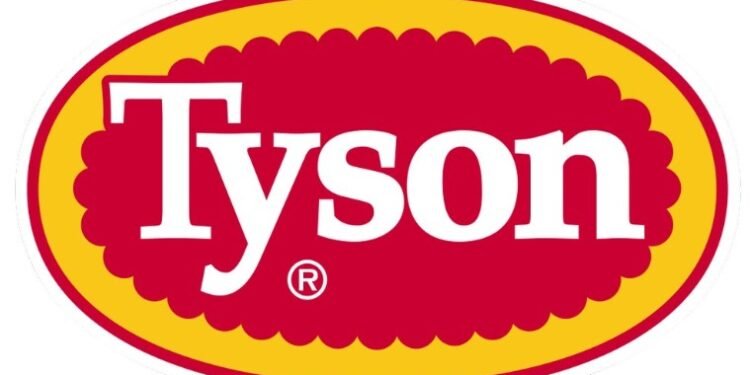With a Water and Sewer Commission of the City of Henderson approval of amendments to the contract between the Henderson Water Utility and Tyson Foods on June 17 and the Henderson City Commission’s approval of the contract on Tuesday, the gravity of the deal is beginning to come to light.
For one, the amended contract keeps Tyson at its Robards plant for another 10 years, allowing 1,200 employees to continue to work there, said Bart Boles, the general manager of HWU.
It also keeps those connected to Tyson—chicken hatcheries, chicken farmers, feed mills and others—working in a region of southern Henderson County, McLean and Webster counties where those businesses have become a fabric of life.
Above anything, Boles said keeping the jobs was the biggest driver in getting the contract signed.
“It not only affects the city of Henderson, but it affects the region,” Boles said. “If Tyson’s not here, then those chicken farmers aren’t here. People have no idea the effect this could have had if Tyson decided to leave.”
Tyson is the biggest HWU water and sewer customer in the county, using about 85-90% of the water produced at its south water plant in Robards, which is located nearby the chicken plant, Boles said.
Boles said there was no clear indication Tyson would go anywhere. All that local officials knew was that Tyson’s management have always had concerns about water costs—the plant uses about 2 ½ million gallons of water per day—and were always looking to decrease them, if possible, as any business would, Boles said.
And there had been eight Tyson plant closures across the nation in the previous 1 ½ years which gave Boles some “concern.”
Henderson Economic Development Executive Director Missy Vanderpool said since she’s been on the job—four years—and since colleague Whitney Risley has been on the job—seven years—talking to Tyson about water prices is a regular occurrence. Again, nothing was known but Tyson moving “was a possibility” which would have effects on everyone nearby, Vanderpool said.
Henderson Mayor Brad Staton agreed, saying discussions were serious enough it was felt “that they could have left.”
Boles said on average the chicken plant pays HWU $6 million a year for water and wastewater, but that HWU expends more than $5 million on upkeep and services directly related to Tyson. The net profit for HWU is somewhere around $500,000, Boles said.
The original contract was between HWU and Hudson, which was Tyson’s predecessor, and began in 1995, Boles said. That contract was in place when Tyson took over and remained until 2018, but since then, the same contract had been re-upped on a yearly basis, Boles said.
It is structured in a ‘cost plus percentage’ structure in which Tyson pays a piece of what it costs to run the south water plant and a percentage based on its water usage, Boles said.
Boles said both the payments for the costs to run the plant and the percentage to be paid on water usage were decreased in the contract. He didn’t know at the Tuesday afternoon interview with the Hendersonian the exact percentage decrease of water use payment.
But he did say that Tyson would reap about $1 million in savings of payments for its share to run the plant. HWU in the past few years has made cost-saving improvements to the south water plant, and those are passed on to its customers, including Tyson.
Boles said of those changes, a couple seemed bad luck but ended up “blessings.”
For example, the south water plant had been getting its water supply from the Big Rivers intake system on the Green River, but when the pump failed there on a weekend in April 2022, HWU had to spring into action to replace it.
A barge was anchored near the Big Rivers intake and five smaller pumps were put there to replace the work that the Big River intake had been doing, Boles said. Though an initial blow, the replacement pumps cut costs tremendously—from the monthly $65,000 HWU had been paying Big Rivers for the water to $25,000 for getting its own with the temporary pumps, Boles said.
Another lucky change that didn’t seem lucky at the time occurred when Waste Management in Winslow, Ind., decided a couple of years ago that it would no longer accept the sludge the water plant produces. It was another conundrum, but working with city of Henderson officials, the utility was able to secure a deal to dump its sludge at the West Daviess County Landfill, Boles said.
This deal also involved a cut in costs—from $45 per ton at Waste Management to $27 per ton at the Daviess County dump, not to mention the shorter hauling trips and associated fuel cost savings, Boles said.
One cost-saving initiative that was planned involves a 2-acre solar field on a parcel between the south water plant and the Tyson plant that was constructed in summer 2022, Boles said. It provides 1.2 megawatts of electricity to the water plant with power savings of $20,000 per month that are passed on to Tyson, he said.
“These are all things we’ve been able to do to help Tyson,” Boles said.
Water rate talks began again in 2023 and continued through the new year. These early talks involved mainly local officials and Tyson management, Boles said.
According to Boles and Vanderpool, a bit more urgency in the talks occurred when Kentucky Agriculture Commissioner Jonathan Shell got involved after meeting local Tyson officials at a Bowling Green Tyson plant opening in January.
That, in turn, led to a March 5 meeting held at Henderson Community College, where a multitude of officials from the city of Henderson, Henderson County Fiscal Court, HED, HWU, Tyson—local and corporate—and the state, including Shell, were on hand. That’s when the 10-year deal was struck, according to Boles.
“The way we all talked about it is it helped save 1,200 jobs,” Vanderpool said.
For the contract to be finalized, it next needs to be approved by the Henderson County Fiscal Court, Webster County Fiscal Court and McLean County Fiscal Court, Boles said.
“This is one of the bigger things that I’ve been a part of,” said Boles, who recognized all the local, state and Tyson officials working to get the contract signed. “For me, this is a big deal.”























